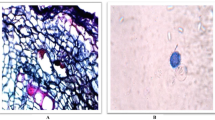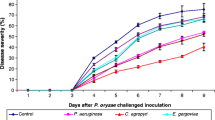Abstract
Endophytic bacteria inhabiting in plant root and facilitate the plant growth and health. Among 28 isolates, two isolates Pseudomonas aeruginosa and Pseudomanas pseudoalcaligenes were selected to evaluate their ability as a biological agent against fungal pathogen Pyricularia grisea responsible for fungal blast in paddy. The paddy plants were inoculated with these isolates during the initial stage of growth and latter infected with fungal pathogen under greenhouse condition. The observation showed that, the two endophytic isolates were able to activate phenolics and flavonoids production and induction of PR proteins like enzymes β-1,3-glucanase and catalase in paddy even in absence of pathogen and when such plant infected by fungal pathogen like Pyricularia grisea, it showed more resistant against it. Production of such enzymes due to endophytic bacteria resulted in reduction of its autophagy dependent cell death as reduced red fluoroscence in bacterized plant cell, observed under fluorescence microscope and also induction of β-1,3-glucanase and catalase gene in paddy. Uses of such beneficial bacteria in diverse agro-ecological system can be broadly use to develop pre-formed defence activation to develop resistance against broad range of pathogen in important crops.



Similar content being viewed by others
References
Bassham DC, Laporte Marianne, Marty Francis, Moriyasu Yuji, Ohsumi Yoshinori, Olsen Laura J, Yoshimoto Kohki (2006) Autophagy in development and stress responses of plants. Autophagy 2:2–11
Benhamou N, Gagn´e S, Quere DL, Dehbi L (2000) Bacterial mediated induced resistance in cucumber: Beneficial effect of the endophytic bacterium Serratiaplymuthica on the protection against infection by Pythiumultimum. Phytopathology 90:45–56
Choudhary DK, Prakash A, Johri BN (2008) Induced systemic resistance (ISR) in plants: mechanism of action. Indian J Microbiol 47(4):289–297
Doty SL (2016) Plant–microbe symbiotic interactions. Plant Mol Biol 90:535
Etminani F, Harighi B (2018) Isolation and identification of endophytic bacteria with plant growth promoting activity and biocontrol potential from wild pistachio trees. Plant Pathol J 34(3):208–217
Ildikó M, Georg N, Zsolt B, Gábor Makara (1999) Muscarinic M1 and M3 receptors are present and increase intracellular calcium in adult rat anterior pituitary gland. Brain Res Bull 48:449–456
Jeffries P, Gianinazzi S, Perotto S, Turnau K, Barea JM (2003) The contribution of arbuscularmycorrhizal fungi in sustainable maintenance of plant health and soil fertility. Biol Fertil Soils 37:1–16
Jha Y, Subramanian RB (2014) Under saline stress plant growth promoting bacteria affect growth, photosynthesis and antioxidant activities in paddy. Int J Agric Environ Biotechnol 7:489–497
Jha Y, Subramanian RB, Patel S (2011) Endophytic bacteria induced enzymes against M. grisea in O. sativa under biotic stress. AJBAS 3:136–146
Justyna M, Kamil K, Anna K (2014) Flavonoids as important molecules of plant interactions with the environment. Molecules 19:16240–16265
Kanazawa T, Taneike I, Akaishi R (2004) Amino acids and insulin control autophagic proteolysis through different signaling pathways in relation to mTOR in isolated rat hepatocytes. J Biol Chem 279:8452–8459
Kaur C, Kapoor HC (2002) Antioxidant activity and total phenolic content of some Asian vegetables. Int J Food Sci Technol 37:153–161
Kavitha K, Nakkeeran S, Chandrasekar G (2012) Rhizobacterial-mediated induction of defense enzymes to enhance the resistance of turmeric (Curcuma longa L) to Pythium aphanidermatum causing rhizome rot. Arch Phytopathol Plant Prot 45:199–219
Kawai R, Igarashi K, Yoshida M, Kitaoka M, Samejima M (2006) Hydrolysis of beta-1,3/1,6-glucan by glycoside hydrolase family 16 endo-1,3(4)-beta-glucanase from the basidiomycete Phanerochaete chrysosporium. Appl Microbiol Biotechnol 71(6):898–906
Laluk K, Mengiste T (2010) Necrotroph attacks on plants: wanton destruction or covert extortion? Arabidopsis Book Am Soc Plant Biol 8:e0136
M’Piga P, Belanger RR, Paulitz TC, Benhamou N (1997) Increased resistance to Fusarium oxysporum f.sp. radicis lycopersici in tomato plants treated with the endophytic bacterium Pseudomonas fluorescens strain 63–28. Physiol Mol Plant Pathol 50:301–320
Mandal SM, Chakraborty D, Dey S (2010) Phenolic acids act as signaling molecules in plant-microbe symbioses. Plant Signal Behav 5(4):359–368
Mohammadi M, Kazemi H (2002) Changes in peroxidase and polyphenol oxidase activities in susceptible and resistant wheat heads inoculated with Fusarium graminearum and induced resistance. Plant Sci 162:491–498
Pan SQ, Ye XS, Kuc J (1991) Association of b-1,3-glucanase activity and isoform pattern with systemic resistance to blue mould in tobacco induced by stem injection with Perenosporatubacina or leaf inoculation with tobacco mosaic virus. Physiol Mol Plant Pathol 39:25–39
Ramalingam R, In-Jung L (2013) Ameliorative effects of spermine against osmotic stress through antioxidants and abscisic acid changes in soybean pods and seeds. Acta Physiol Plant 35:263–269
Ramamoorthy V, Raguchander T, Samiyappan R (2002) Induction of defense related protein in tomato roots treated with Pseudomonas fluorescent Pf1 and Fusariumoxysporum f. sp. Lycopersici. Plant Soil 239:55–68
Ramos Solano B, BarriusoMaicas J, Pereyra de la Iglesia MT, Domenech J, Gutierrez Manero FJ (2008) Systemic disease protection elicited by plant growth promoting rhizobacteria strains: relationship between metabolic responses, systemic disease protection, and biotic elicitors. Phytopathology 98:451–457
Rasool S, Ahmad A, Siddiqi TO, Ahmad P (2013) Changes in growth, lipid peroxidation and some key antioxidant enzymes in chickpea genotypes under salt stress. Acta Physiol Plant 35:1039–1050
Redfern J, Kinninmonth M, Burdass D, Verran J (2014) Using soxhlet ethanol extraction to produce and test plant material (essential oils) for their antimicrobial properties. J MicrobiolBiol Educ 15(1):45–46
Rojas CM, Senthil-Kumar M, Tzin V, Mysore KS (2014) Regulation of primary plant metabolism during plant-pathogen interactions and its contribution to plant defense. Front Plant Sci 5:17
Ryan PR, Germaine K, Franks A, Ryan DJ, Dowling DN (2008) Bacterial endophytes: recent developments and applications. FEMS Microbiol Lett 278:1–9
Sambrook J, Fritschi EF, Maniatis T (1989) Molecular cloning: a laboratory manual. Cold Spring Harbor Laboratory Press, New York
Sanevas N, Sunohara Y, Matsumoto H (2007) Characterization of reactive oxygen species-involved oxidative damage in Hapalosiphon species crude extract-treated wheat and onion roots. Weed Biol Manag 7:172–177
Savatin DV, Gramegna G, Modesti V, Cervone F (2014) Wounding in the plant tissue: the defense of a dangerous passage. Front Plant Sci 5:470
Singh PP, Shin YC, Park CS, Chung YR (1999) Biological control of fusarium wilts of cucumber by chitinolytic bacteria. Phytopathology 89:92–99
Su Y, Guo J, Ling H, Chen S, Wang S (2014) Isolation of a novel peroxisomal catalase gene from sugarcane, which is responsive to biotic and abiotic stresses. PLoS One 9(1):e84426
Torres M, Palomares O, Quiralte J, Pauli G, Rodríguez R, Villalba M (2015) An Enzymatically Active β-1,3-glucanase from ash pollen with allergenic properties: a Particular Member in the Oleaceae family. PLoS One 10(7):e0133066
Umamaheswari A, Pradhan D, Hemanthkumar M (2010) Identification of potential leptospira phospho heptose isomerase inhibitors through virtual high throughput screening. Genom Proteom Bioinform 8:246–255
Van Loon LC, Rep M, Pieterse CM (2006) Significance of inducible defense-related proteins in infected plants. Annu Rev Phytopathol 44:135–162
Author information
Authors and Affiliations
Corresponding author
Rights and permissions
About this article
Cite this article
Jha, Y. Endophytic bacteria mediated anti-autophagy and induced catalase, β-1,3-glucanases gene in paddy after infection with pathogen Pyricularia grisea. Indian Phytopathology 72, 99–106 (2019). https://doi.org/10.1007/s42360-018-00106-5
Received:
Revised:
Accepted:
Published:
Issue Date:
DOI: https://doi.org/10.1007/s42360-018-00106-5




